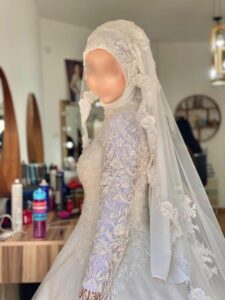World Hijab Day, celebrated on February 1 for the 10th consecutive year, was established to encourage women from all religious backgrounds to wear a head scarf in order to normalize traditional head covering. But while hijab has been embraced by some women who have taken it to a high-fashion design level, others completely reject it as a symbol of gender oppression.
The hijab or head scarf, is a clothing accessory that observant Muslim women wear as part of Islam’s modest dress code. The headscarf can vary in shape and color according to the culture or location where it is worn. Hijab is compulsory for women in countries such as the Islamic Republic of Iran and Afghanistan under the Taliban regime.
The current wave of protests in Iran was sparked by the death of 22-year-old Iranian Kurd woman Mahsa Amini while in the custody of the government’s morality police, who arrested her for not wearing her hijab properly. As an act of support for the Iranian protesters’ cause, many women in Iran and around the world have taken off their head scarves and some have burned them, further politicizing the hijab.
Astiyaz Haghighi and Amir Mohammed Ahmadi, a young engaged couple living in Iran, were each reportedly sentenced this week to more than 10 years in prison after posting a video of themselves dancing in front of the Azadi Tower in Teheran, which went viral. It is not only the dancing together that got them into trouble, but also the fact that Haghighi is not wearing a hijab. They were convicted of “encouraging corruption and public prostitution” and “gathering with the intention of disrupting national security.”
“Everyone has seen the news and knows about Mahsa Amini being beaten to death over her hijab. But Mahsa is only the tip of the iceberg. Women have not only been killed but they have also been raped to death over hijab,” Yasmine Mohammed, a Canadian writer and women’s rights activist, told The Media Line. “The tragedies are not only in Iran, they are global,” she added.
As Islamists are spreading the propaganda that hijab is a choice, I wanted to counter that lie with stories from around the world of women who had no choice. Women who were harassed, beaten, imprisoned, attacked with acid, disowned and even killed. Hijab is forced on young girls before they are old enough to make choices.
Haneen Hijab Design is a business in northern Israel that designs high-fashion hijabs. Haneen, the 25-year-old designer, told The Media Line that the hijab for her is like any other piece of clothing, but says it is essential for Muslims.
Women, including Muslims who follow the rules of modesty, like to wear beautiful clothing and follow fashion trends in their choice of apparel. “The same applies to the hijab. Every touch we put on increases our beauty,” she said.
High-fashion-designed hijabs are part of a greater trend called “modesty fashion,” in which clothes that are considered to be modest in Muslim communities are modernized and become part of global fashion trends.
Niloufar Momeni, a female sports journalist who lives in Canada but spent her teenage years being forced to wear a hijab in the Islamic Republic of Iran, believes that the “modest fashion” industry was created to normalize hijab for Westerners and those who don’t know the suppressive background of the head covering.
“They use colorful scarves and are not as restricted, but that still does not take away from the fact that if a woman doesn’t wear her hijab, she faces lashing and imprisonment in many Islamic countries,” she told The Media Line.
Haneen sees designer hijabs as a way of wearing modern clothing without leaving aside her Islamic beliefs. “I love everything modern and everything related to fashion, especially the hijab,” she said. “Hijab means a lot to me and, when I wear the hijab, I feel confident and feel very comfortable,” she said.

A bridal hijab from Haneen Hijab Design in northern Israel. (Courtesy of Haneen Hijab Design)
World Hijab Day is not celebrated by everybody. Mohammed said that as a direct response to what she considers to be the Islamist propaganda spread through World Hijab Day, she created a parallel No Hijab Day, also celebrated on February 1, where she invites women who were forced to wear the hijab to share their stories.
“As Islamists are spreading the propaganda that hijab is a choice, I wanted to counter that lie with stories from around the world of women who had no choice. Women who were harassed, beaten, imprisoned, attacked with acid, disowned and even killed. Hijab is forced on young girls before they are old enough to make choices,” she said.
I am a hijab–wearing woman living in the post-9/11 United States. I graduated in the top 10% of my class from one of the most rigorous universities in the country and became a subspecialized physician. Every day my existence pushes back against the notion that women who wear hijab are oppressed, uneducated or backwards.
Dr. Nour Akhras writes in her article, “Nevertheless, We Persist With Hijab,” published on the World Hijab Day website, that awareness of hijab is important for Muslim women living in the West in these times. “I am a hijab–wearing woman living in the post-9/11 United States. I graduated in the top 10% of my class from one of the most rigorous universities in the country and became a subspecialized physician,” she said.
“Every day my existence pushes back against the notion that women who wear hijab are oppressed, uneducated or backwards,” she added.
But Mohammed thinks that these trends, including modest fashion, are not empowering women as they appear to.
“The modest fashion industry is capitalizing on the oppression of women. It is a way to monetize misogyny. There are many industries that capitalize on human suffering, but what makes the modesty industry so insidious is that it pretends to be feminist or empowering for women,” she said.